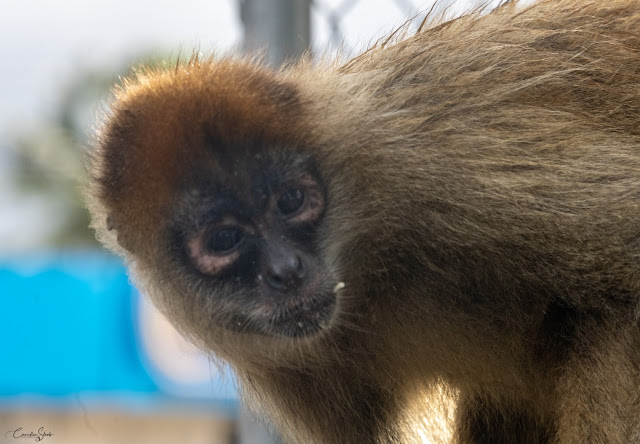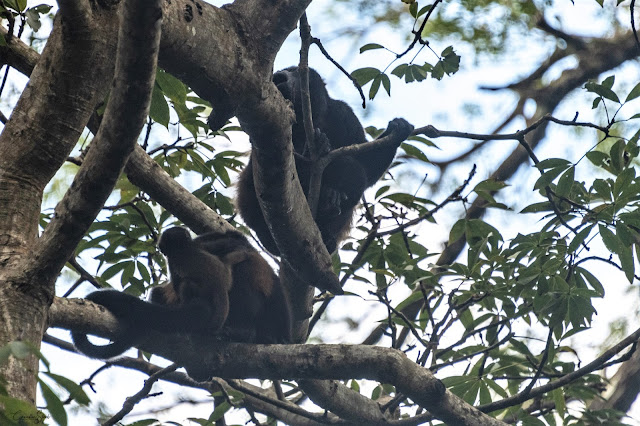I am not sure if I would be as fascinated as I was had I had "wildlife" roaming around my neighborhood at all times. Mind you I do have some wild life where I live....deer are one type of wild life, as are turkey vultures, racoons, and various birds.OH!! let's not forget the mice. I live somewhat in the country with a farmfield butting up right to my yard, hence field mice are....well they are part of our life until.........I'll stop right here.While all those "wild life" surouding me are great, there is something about monkeys and wild birds (not found in my area) and raccoon's cousins (again not found in my area) that are beyond fascinating to me.Hence, when a monkey decides to hang around and wait for someone to feed them bananas, comes into my vision and the camera's vision...well you know what happens.
This particular monkey is called spider monkey. It is in the endangered list of wild life
Spider monkeys, with their powerful prehensile tails, are the most agile species of monkey found in Costa Rica. The exact number of species that exists is a topic of debate, but scientists agree that there are either four or five distinct types. The most common to Costa Rica is the black-handed spider monkey, known in Spanish as the mono arana or mono colorado.
These primates have an endearing physical appearance. The textured area at the tip of their tails facilitates movements such as collecting water, picking fruit, and hanging from trees. The tail is longer than the length of the head and body combined, ranging from 25 to 33 inches. The prehensile tail has evolved to allow the animals to grasp, dangle, and swing effortlessly from the treetops – virtually functioning as a fifth arm.
Extraordinarily long limbs are slender and dark in color, with arms stretching 25% longer than legs. Males and females are roughly the same size, weighing between 13 and 20 pounds. Spider monkeys have dark faces, black feet, potbellies, and black, brown, or rust-colored body hair. They have no opposable thumbs, making social grooming difficult. While this used to be the most common variety of monkey in the country, sightings in the wild are now considered a rarity. The arboreal creatures seldom descend from the treetops; to survive they require large stretches of unobstructed forest, which have been greatly diminished over the last few decades.
Extremely expressive social creatures, spider monkeys communicate with body gestures as well as with screeches, barks and whines that can be heard on the forest floor as far away as 3,280 feet, and audible up to 6,560 feet above the canopy. Spider monkeys subsist primarily on ripened fruit, with leaves, flowers, insects, bark, honey, and roots making up the remaining 20-30% of their diet. Jaguars, eagles, snakes and humans are the animals’ only predators. Spider monkeys are quick and flexible, with a life span of roughly 27 years in the wild and 30 plus years in captivity.
All of the seven subspecies of black-handed spider monkeys are classified as endangered, critically endangered, or vulnerable on the Red List created by the International Union for Conservation of Nature and Natural Resources (IUCN). Spider monkeys play a critical role in the ecosystem by dispersing flower and plant seeds in their dung, which aids in rainforest habitat regeneration. Many inhabited areas are protected by Costa Rica’s extensive national park system, and by small-scale programs like Conservacion y Libertad de los Monos, or Conservation and Freedom of the Monkeys.
Of course the spider moneky is not the only wild life coming close to humans around this area, the coatis is another cute guy to step out.
Coatimundi (or coati for short) locally, they’re known as pizotes is a raccoon-like creature with a long snout, pointy tail and endearing personality. The white-nosed coati is one of the country’s most prolific mammals,
A large male coati can tip the scales at nearly 18 pounds, and with his dark, brownish-red fur and nocturnal preferences, it is often mistaken for a large feline. Make no mistake, these resourceful creatures belong to the same family as raccoons, and are known for their ability to adapt to just about any habitat or terrain. They will feast on crocodile and bird eggs, crabs, shellfish, fruits, leaves, nuts, lizards, invertebrates, birds, and carrion as well. Often seen in bands of 20 members, coatis are skilled climbers and, with the aid of their agile prehensile tails, can amble up the tallest of trees in search of food or safety.
If you spot a solitary pizote, it is most definitely a male, who communicates through snorting, twittering and grunting sounds in an effort to define territory. The males seek out the company of others only for mating, and otherwise spend their days solo. Females generally make their nests in the safety of trees and give birth to a litter of 4-7 young. In Costa Rica, pizote breeding season normally coincides with the start of the rainy season, to ensure all clan members have access to abundant food.
Luckily, other than habitat loss, the coati faces few challenges in its survival in Central America. Since they adapt so well and eat a wide variety of foods, white-nosed coati populations are thriving in Costa Rica, where large clans are often witnessed in and around protected areas.
When you think you have spotted all the wild life around, looking down.....look up! Because somewhere in the distance there is a howler looking at you.
The Mantled Howler monkey is most commonly found in Costa Rica. These monkeys are large with mostly black fur, and tails that are longer than their bodies.Howler monkeys earn their name too, as they are most famous for their loud howls. The howls can sound like screeching or screaming in the forest, and can travel as far as three miles. So, if you hear a loud howling noise it is most likely a howler monkey, so look up in the trees as they are hard to spot as they blend into their environment.
Howlers are one of only a small group of monkeys that build nests. Because of this, they are very unlikely to be on the ground ever. You’ll have to look up high to catch a glimpse of them!These monkeys are large and slow-moving, and can be seen eating canopy leaves, fruit, nuts, and even flowers. Once in awhile a howler monkey will feel frisky and has been known to raid a bird nest to get the egg.
Howler monkeys are one of the species that are sometimes kept as pets even though this is illegal, since they are not likely to be aggressive. However, this is one of the things that threatens them, along with capture for zoos and the destruction of their natural habitat.
Our next destination is Cañas Castilla.
(source)
(source)
(source)
















































What fun! And what wonderful captures!
ReplyDeleteThanks...it was fun capturing them.
DeleteGreat photos, what an opportunity. Love the monkeys, so cute. Strange seeing the spider one in an urban setting too.
ReplyDeleteIt definitely was a treat to be that close to the wild life.
Delete